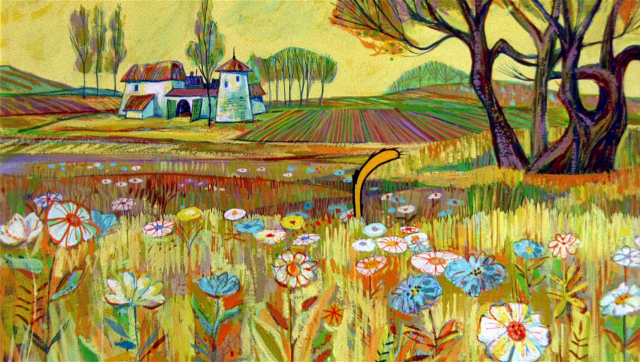Gay Purr-ee is painterly and often spellbinding

Gay Purr-ee (1962) is painterly and often spellbinding.
It’s been forgotten, but it brings together tons of excellent ideas. Chuck Jones (Looney Tunes) co-wrote it, and Judy Garland stars. The plot is basic and a bit illogical, but the music and definitely the visuals make up for it.
Gay Purr-ee was created by United Productions of America. Though best-known for Mr. Magoo, they have many short masterpieces that most people have never heard of. UPA has always been the underdog of the animation industry, having been founded on the back of a Disney animator strike in 1941. They cultivated a mature atmosphere with their cartoons, though most of them have all-ages appeal. In separating from Disney, they also separated from Walt Disney’s mandates - most noticably, Disney’s obsession with realistic animation. Over the next decade UPA cultivated a style that is now known as limited animation. In limited animation, the drawings don’t move as much, saving money. This is common in anime today, but was revolutionary at the time and still takes some getting used to.
Also revolutionary was how UPA used limited animation. UPA’s style co-evolved with general 1950s-1960s flat design trends, summarized in a book called Cartoon Modern which I am now half-remembering for this article (with Wikipedia sprinkled in too). UPA didn’t freeze its drawings in place just to save money. No, they had a story to tell, and limited animation was the way to tell it.
Instead of laboring over the stairway of Gerald McBoing-Boing’s house, they would draw a few lines to evoke a stairway. (Gerald McBoing-Boing, 1951)
It’s not for everyone, but I adore this style. In motion it’s clearly not a trick. When UPA only puts 3 things on screen, they make sure each one exactly conveys the intended emotion.
By the time they made Gay Purr-ee, UPA was fading. Perhaps because of the need for mainstream relevance, or maybe because they had already been making modern cartoons for a decade, Gay Purr-ee is conventional by UPA standards. But there are touches of the modern style that would be completely out of place in a golden-era Disney movie, and that’s what makes this movie such a looker.
The assistant-villains, four black cats, are a perfect example.
Are they really four separate cats? They often merge together and move like a mangled liquified rat-king with paws and tails in every direction. They are SOLID black from every angle and in every light. Only eyes and teeth in a menacing sillhouette. And given the labor history of UPA, is it possible they took inspiration from the black cats of the Industrial Workers of the World? Either way, it’s an all-time great villain design.
The other genius aesthetic decision was matching plot with visuals.

It takes place in 1890s France, so they borrowed an impressionist painting style for many backgrounds.
The painted look is an absolute knock-out, and the other styles are good too. One of these style transitions creates one of the most bizarre scenes I’ve ever seen. In the movie, it’s not confusing, but trying to understand why this sequence was approved had me joyously perplexed.
While I’m not sure any of the songs are amazing, they are catchy. Judy Garland performs them well and the song sequences are almost all the high points of the movie.
Finally, the moment I’ve been dreading. The story. It’s some boring-ass “girl in the big city” plot. Some of the touches and jokes are good, but the main throughline is average. The characters are tolerable (except the main villain) but not extraordinary. The story is lumpy, too: the farm where the journey begins is quickly forgotten, along with the woman there. And there’s a kind of hero pit-stop to prevent the movie from ending too soon, only to have this pit-stop overcome 20 minutes later. The main plot is too slow while every component of it moves too fast – there’s basically no character development. And one of the side-heroes is a proto-Scrappy-Doo.
(Updated note: It’s plausible that two brief moments are racist against Asians. Look into UPA’s A Few Quick Facts Japan for the same archetype. I left it out of the review because I couldn’t prove it, and figured few would even watch the movie regardless.)
Gay Purr-ee proves that UPA still had talent and an artistic statement to make as late as 1962. It’s colorful and a lot of fun.